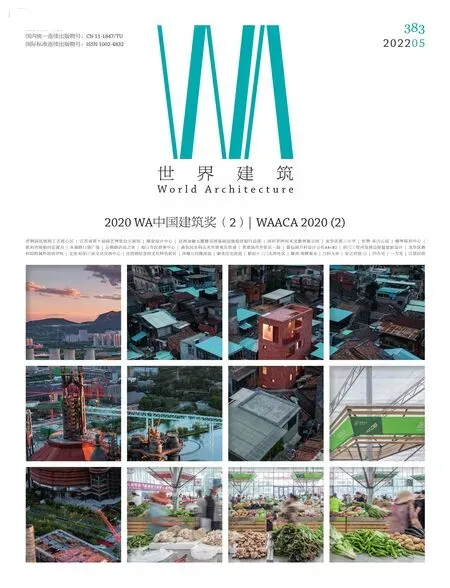“大隐于市”:蒙圣住宅改造,广州,广东,中国
URBANUS都市实践
业主:上海东方卫视“梦想改造家”栏目
主持建筑师:孟岩
项目建筑师:姜轻舟
项目组:张超贤
施工图合作:北京世纪中天国际建筑设计有限公司,深圳中咨建筑设计有限公司
用地面积:27.9m2
建筑面积:96.4m2
建筑高度:12.7m
设计时间:2018.04-2018.07
建设时间:2018.07-2018.10
摄影:张超,URBANUS都市实践
Client:DRAGON TV "Dream Home" TV Show
伴随着老龄化社会的不断发展,中老年患者人群在临床中疾病的发生率也在随之提高。冠心病心绞痛也属于发生率比较高的疾病类型,伴随着老龄化社会的发展其发病率不断提升[1]。冠心病心绞痛主要是多种原因导致心肌缺血、缺氧,并形成系列性的症状,如气促、气短以及胸痛等,严重时还会影响患者的生命健康[2]。临床中患者往往会因为疾病的疼痛感、对治疗的恐惧心态形成严重的负面情绪,导致对医护服务形成抵触。对此,为了持续提升临床护理水平,以我院的部分患者为例,以对比分析方式探讨关于冠心病心绞痛患者的临床最佳护理服务措施,现报告如下。
Principal Architect:MENG Yan
Project Architect:JIANG Qingzhou
Team:ZHANG Chaoxian
(LDI) Structure/MEP:Beijing Century Peak International Architecture Design Co.,Ltd.,China Building Design Consultants,Shenzhen
Site Area:27.9 m2
Floor Area:96.4 m2
Building Height:12.7 m
Design Period:2018.04-2018.07
Photos:ZHANG Chao,URBANUS
广州海珠区的蒙圣社区,因传说秦朝名将蒙恬后裔在此定居而得名。项目所在的上蒙圣街是一条幽深的小巷,原建筑是1985 年屋主自建的3 层半砖混结构小楼,单层建筑面积仅有22m2,四周被密集的房屋包围。
东侧紧贴临屋外墙,北侧和西侧距邻家只有90cm 和30cm,南面一条宽80cm 的幽暗窄巷是入户的唯一通道,仅容两人错身而过。房子不仅小、挤、暗、与邻屋对视、热工性能差,还有结构隐患,是旧城改造中典型的疑难杂症。
改造设计由内及外,在极小的空间内重新组织生活功能,用雕镂的方法使建筑内部上下贯通,房中有房,小中见大;顶层引入天光,明暗开合有度。施工从整体结构加固着手,拆除原楼梯,将原先陡峻的单跑梯改为舒适的折返梯,形成新的垂直流线。在每一层均设有独立卫生间。南北两侧外墙上特殊的采光斗将天光引入底层,墙面不同位置开辟出一系列独特的景窗,不仅为各层带来极佳的自然采光,也将周边风景借入斗室之中。四层顶楼有一个空灵剔透的小房间和一个可以四面环顾市景的露台,它没有固定的功能,适于赏月、饮茶和沉思。
一个房子,不仅需要容纳人的身体,还应该容纳人的精神和梦想。整栋房子虽小,但足以承载大都会喧嚣之上的一份超然物外的恬静。正如《桃花源记》中的“初极狭,才通人”,走过只有一线天光的窄巷,又“复行数十步,豁然开朗”,从下而上经历了一个从幽暗到明亮、从压抑到释放的过程,构建出一个垂直的桃花源式的居住体验。
建筑外墙选用了褐红色天然纹理的小片石材,颜色与周边的老旧建筑相近,随着时间的流逝它细碎的纹理会与环境愈加融合。改造后的建筑低调地融入社区,坐享大都会中“大隐于市”的一方精神天地。
这个仅80m2 的极小独栋住宅是构成广州旧城肌理的一个微小单元,作为一个城市微更新的样本,它对于历史传统深厚的旧城区有着特殊的人文意义,也是对大拆大建的旧城更新模式的批判和抵抗。
The Mengsheng Community in the Haizhu District of Guangzhou got its name out of the saying that the descendants of Mengtian,a legendary general of Qin Dynasty (221 B.C.-207 B.C.),resided here.The project is located on Upper-Mengsheng Street,a long and winding alleyway.The original house was a three-storey brick and concrete structure that the owner built in 1985 with a floor area of merely 22 m2on one single storey.It is closely surrounded by its neighbouring buildings.
The east side of the house brushes against the exterior wall of the adjacent house,while the north and west sides have a spacing of 90 and 30 centimetres with the neighbouring houses.The 80-centimetre-wide alley in the south,which barely allows two people to walk past each other,is the only passage that leads to the entrance.In addition to being small,compressed,dark,and inconveniently close to the neighbouring houses,the building also has poor thermal performance with potential structural hazards.These issues are always typical in the process of regeneration in old city.
The renovation plan started from the interior,aiming to reorganise the vital functions of daily life within the limited space.The operation of carving through the floor plates enables the integration of the whole building and creates interlocking living spaces.Skylights are introduced on the top floor to allow light in the building.Thus,the dark and light spaces,openings and enclosures,are manipulated to make the tiny interior feel much more spacious.The construction started with the reinforcement of the overall structure.The original steep,single-run stair was replaced by a comfortable double-flight one as a device to rearrange the vertical circulation.There is one bathroom on each floor.The customised light wells on the north and south walls bring additional skylight to the dark ground floor.Carefully designed viewing windows at various positions on the walls not only usher in natural light to each floor,but also bring outside views inside.On the top fourth floor,there is a transparent small room and a terrace that overlooks the surrounding city.It is intended to be an open space flexible for various activities such as admiring the moon,having tea or contemplating.

1 改造前外景 Exterior view before renovation
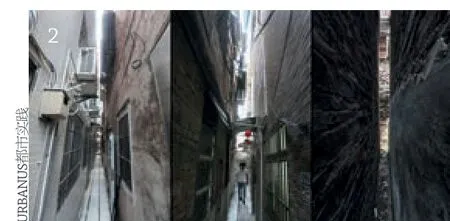
2 改造前巷道 The alley view before renovation

3 鸟瞰 Aerial views

4 鸟瞰 Aerial views

5 鸟瞰 Aerial views

6-9 平面 Floor plans

10 改造前的一层内景 Interior view of ground floor before renovation

11 改造前的二层内景 Interior view of first floor before renovation
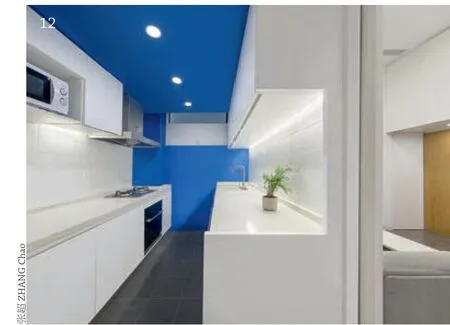
12 首层厨房 Kitchen on ground floor

13 首层起居 室 Living room on ground floor

14 二层家庭 房 Family room on first floor
评委评语
这是广州历史街区内一栋极小住宅的改造实践。建筑师在极其有限的条件下,经过创造性的精心设计,使这个仅80m2的极小住宅焕然一新,居住环境获得很大提升。
改造设计从人的尺度出发,在极小的空间内重新组织生活功能,空间贯通流动,开合有度,小中见大;白色基调与大胆的色彩运用,赋予空间活力;创新设计的采光斗将光线引入底层,各层不同位置的一系列景窗,舒适的光环境和周边的景色,即使是身处斗室,感受也变得生动起来。
作为一个城市微更新的样本,对当下防止大拆大建的城市更新是一个很好的启示。

15 立面 Elevations
A house should not only accommodate people,but also their spirit and dreams.Though this house is tiny,it provides a unique feeling of serenity over the hustle and bustle of the metropolis.Strolling through the dark and narrow alley into the building can be a reminder of an excerpt from the Chinese literary classic,The Peach Blossom Spring,that tells a story of a fisherman’s discovery of an "arcadia" at the end of a grove of peach trees:"At first the opening was very narrow,barely wide enough for one person to go in".After walking through the alley that is illuminated by only a beam of narrowly constrained skylight,eventually "it opened into a flood of light".Here,while one ascends from the ground floor of the building to the top,he gradually emerges from darkness into brightness and his feelings would rise from repression to a sense of release.This experience is akin to that of the fisherman.Thus,the building can be seen as the reconstruction of a vertical "Peach Blossom Spring".
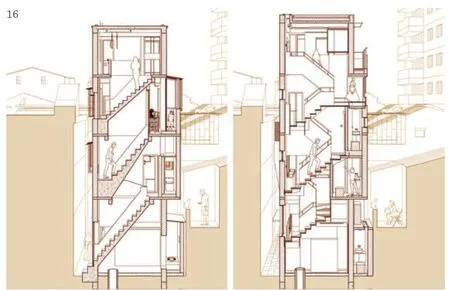
16 楼梯剖面(改造前后)Staircase sectional perspective (before and after renovation)
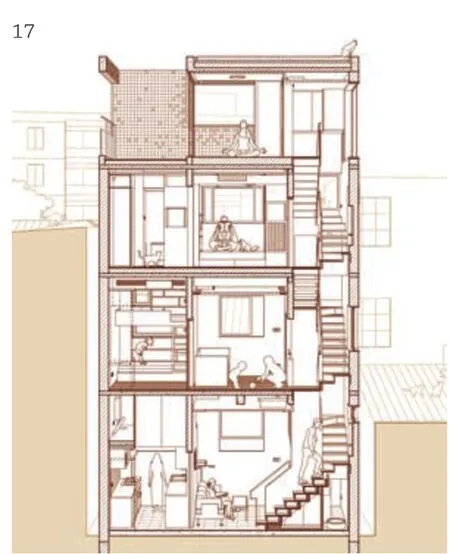
17 东西向剖透视 East-west sectional perspective
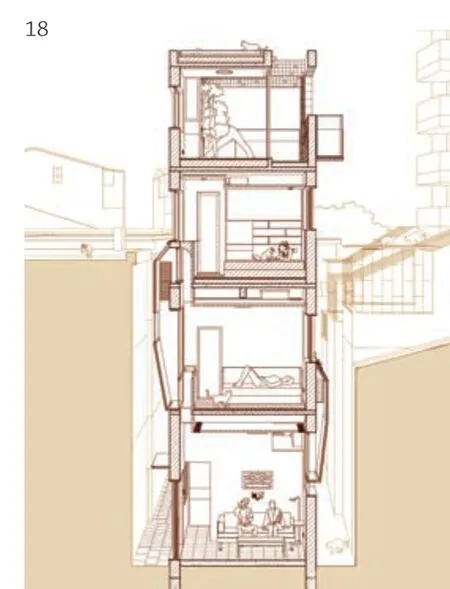
18 南北向剖透视 South-north sectional perspective

19 改造前的三层内景 Second floor inside situations before renovation

20 三层主卧 Master bedroom on second floor
Small pieces of maroon stone with natural grains are chosen for the exterior wall of the house,since their colour matches with the surrounding old buildings.As time passes,the overall texture of the wall will enable the house to be further integrated into the surrounding environment.After renovation,the building still takes on a low-key stance in the neighbourhood,while provides a welcoming retreat for its owners in the bustling city.
This small,single-family house of merely 80 m2is a tiny cell that composes the old city fabric of Guangzhou.As an example of the city's micro-regeneration process,this project has a unique cultural ambition for the revival of the historical clusters within the city.It is also a critique of and resistance to the prevailing urban renewal model of large-scale demolition and construction.
Jury Statement
This is a renovation project of a very small house in a historical neighbourhood of Guangzhou.Under very limited conditions,the architect renovated the tiny house of only approximately 80 m2with a new look,and greatly improved the living environment through careful creative design.
The transformation plan starts from the human scale,reorganising the vital functions of daily life in the extremely small space,which allows the space to be integrated,flexible and balanced -seeing the big through the small.The white tone and bold use of colour endow the space with vitality.Moreover,the innovative lightwell introduces the day light to the ground floor,with a series of viewing windows at various positions on each floor that provide a comfortable light environment and surrounding views:even when one is in a small room the feeling becomes energetic.
As a sample of urban micro-renewal,this project serves as a good inspiration for the current urban renewal that avoids large-scale demolition and construction.□ (Translated by Dandan Wang)

21 楼梯剖面草图 Staircase section sketch
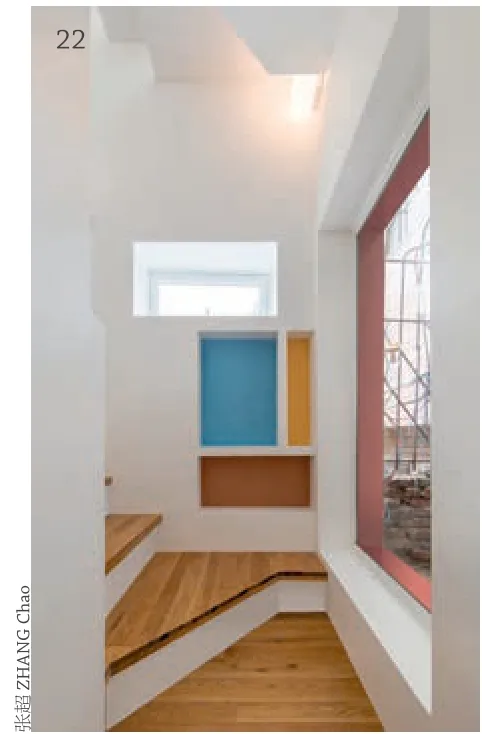
22 首层楼梯夹层储物柜 Stair mezzanine locker on ground floor

23 二层楼梯借景窗 Stair window on first floor
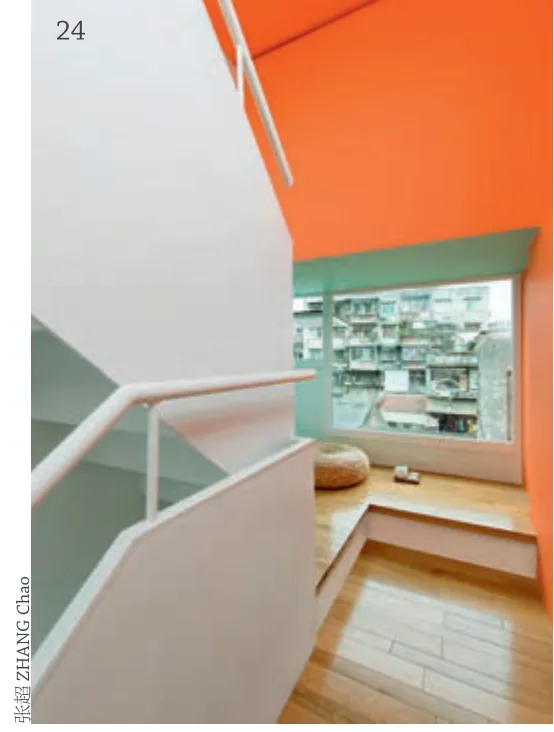
24 三层楼梯夹层平台 Stair mezzanine platform on second floor
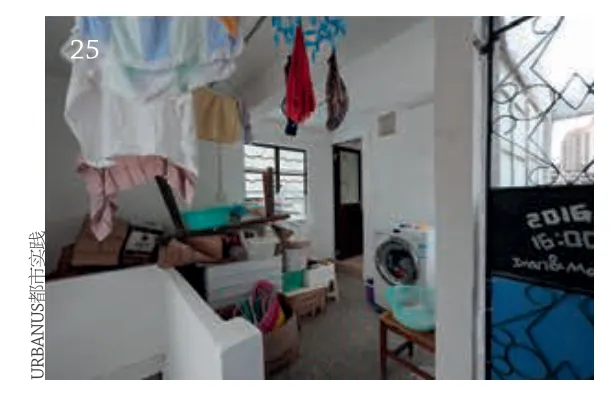
25 改造前的四层内景 Third floor interior view before renovation

26 四层阁楼 Penthouse on third floor

27 改造前的四层露台 Third floor terrace before renovation
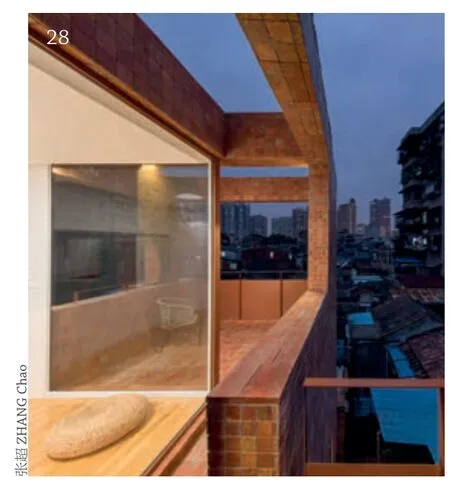
28 四层露台 Terrace on third floor
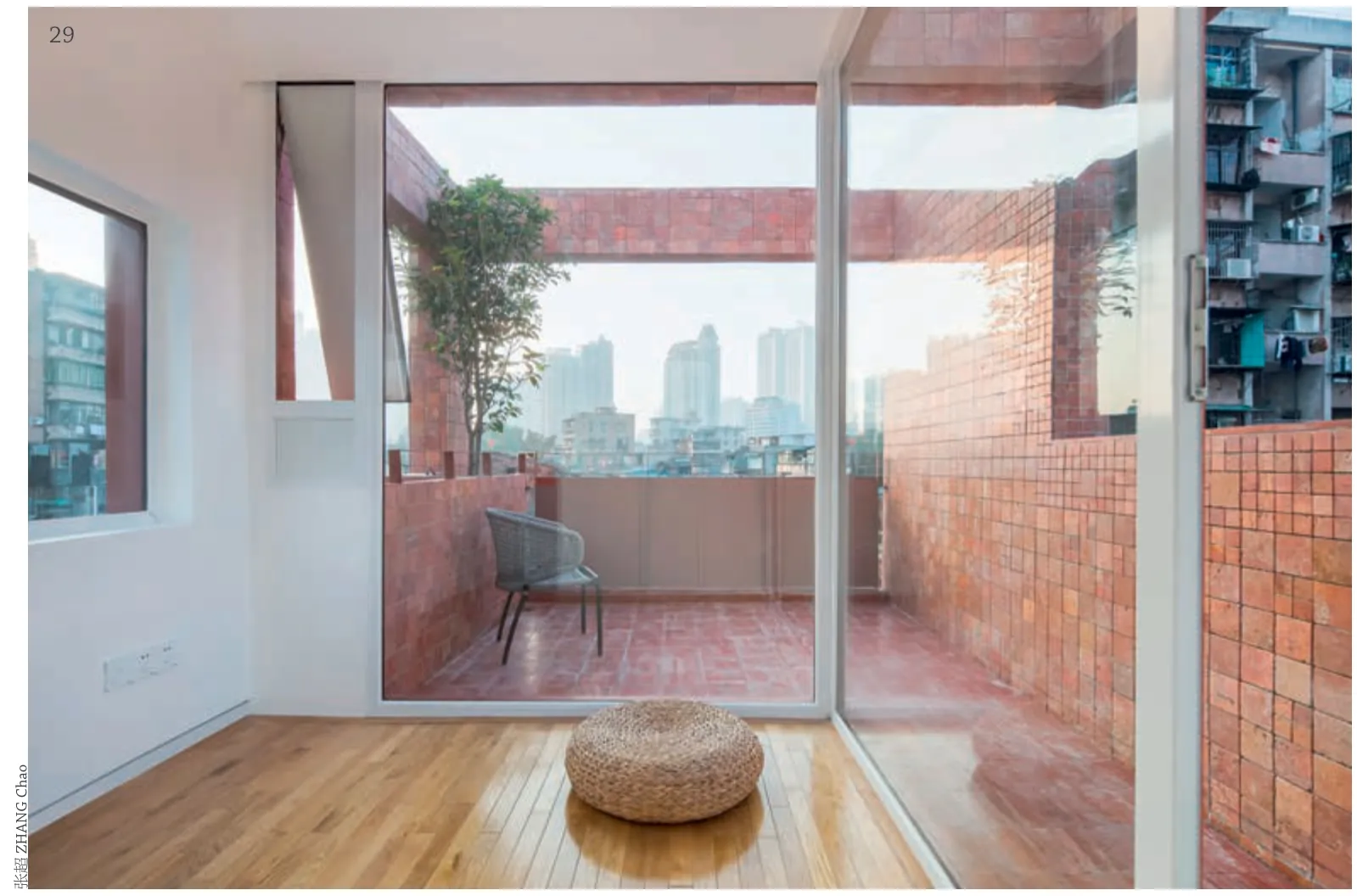
29 四层 露台 Terrace on third floor

